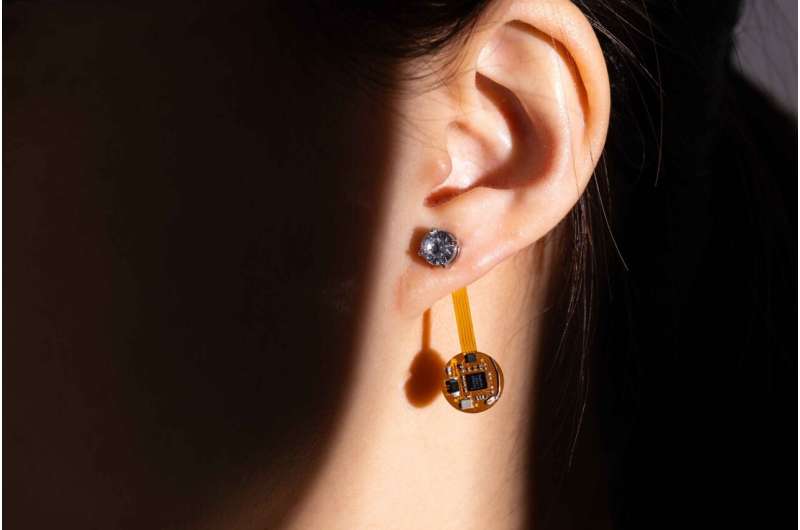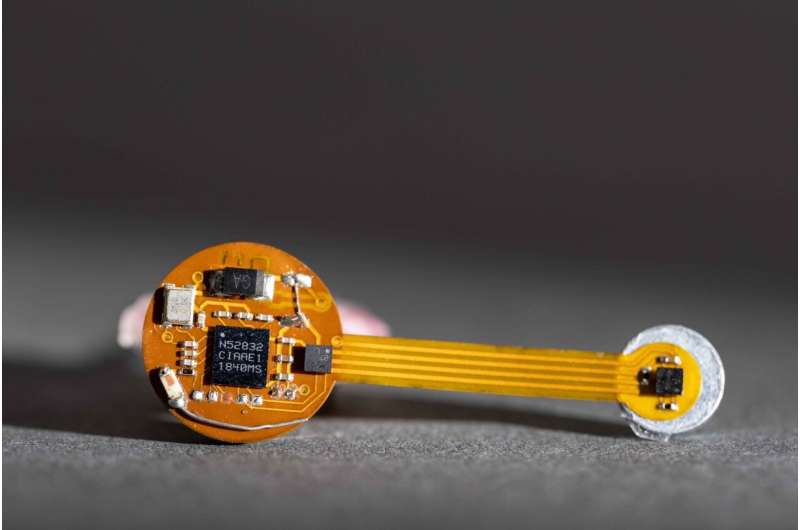
Smart accessories are increasingly common. Rings and watches track vitals, while Ray-Bans now come with cameras and microphones. Wearable tech has even broached brooches. Yet certain accessories have yet to get the smart touch.
University of Washington researchers introduced the Thermal Earring, a wireless wearable that continuously monitors a user's earlobe temperature. In a study of six users, the earring outperformed a smartwatch at sensing skin temperature during periods of rest. It also showed promise for monitoring signs of stress, eating, exercise and ovulation.
The smart earring prototype is about the size and weight of a small paperclip and has a 28-day battery life. A magnetic clip attaches one temperature sensor to a wearer's ear while another sensor dangles about an inch below it for estimating room temperature. The earring can be personalized with fashion designs made of resin (in the shape of a flower, for example) or with a gemstone without negatively affecting its accuracy.
Researchers published their results in Proceedings of the ACM on Interactive, Mobile, Wearable and Ubiquitous Technologies. The device is not currently commercially available.
"I wear a smartwatch to track my personal health, but I've found that a lot of people think smartwatches are unfashionable or bulky and uncomfortable," said co-lead author Qiuyue (Shirley) Xue, a UW doctoral student in the Paul G. Allen School of Computer Science & Engineering.
"I also like to wear earrings, so we started thinking about what unique things we can get from the earlobe. We found that sensing the skin temperature on the lobe, instead of a hand or wrist, was much more accurate. It also gave us the option to have part of the sensor dangle to separate ambient room temperature from skin temperature."
Creating a wearable small enough to pass as an earring yet robust enough that users would have to charge it only every few days presented an engineering challenge.
"It's a tricky balance," said co-lead author Yujia (Nancy) Liu, who was a UW master's student in the electrical and computer engineering department when doing the research and is now at the University of California San Diego. "Typically, if you want power to last longer, you should have a bigger battery. But then you sacrifice size. Making it wireless also demands more energy."

The team made the earring's power consumption as efficient as possible while also making space for a Bluetooth chip, a battery, two temperature sensors, and an antenna. Instead of pairing it with a device, which uses more power, the earring uses Bluetooth advertising mode—the transmissions a device broadcasts to show it can be paired. After reading and sending the temperature, it goes into deep sleep to save power.
Because continuous earlobe temperature has not been studied widely, the team also explored potential applications to guide future research. In five patients with fevers, the average earlobe temperature rose 10.62 degrees Fahrenheit (5.92 degrees Celsius) compared with the temperatures of 20 healthy patients, suggesting the earring's potential for continuous fever monitoring.
"In medicine, we often monitor fevers to assess response to therapy—to see, for instance, if an antibiotic is working on an infection," said co-author Dr. Mastafa Springston, a clinical instructor at the Department of Emergency Medicine in the UW School of Medicine. "Longer term monitoring is a way to increase the sensitivity of capturing fevers since they can rise and fall throughout the day."
More information: Qiuyue Shirley Xue et al, Thermal Earring, Proceedings of the ACM on Interactive, Mobile, Wearable and Ubiquitous Technologies (2024). DOI: 10.1145/3631440
Citation: Smart earrings can monitor a person's temperature (2024, February 7) retrieved 7 February 2024 from https://techxplore.com/news/2024-02-smart-earrings-person-temperature.html
This document is subject to copyright. Apart from any fair dealing for the purpose of private study or research, no part may be reproduced without the written permission. The content is provided for information purposes only.
